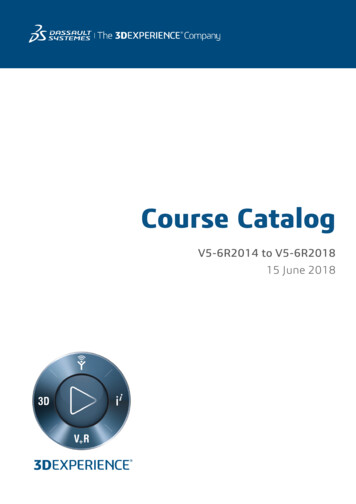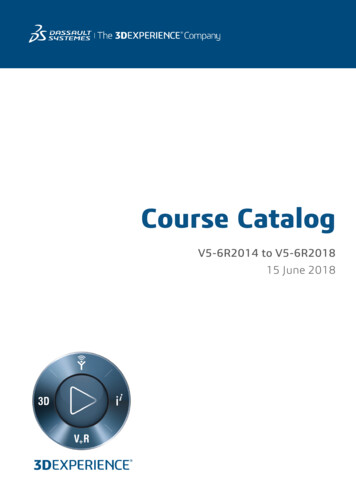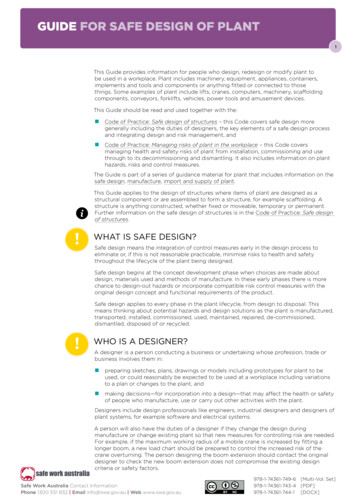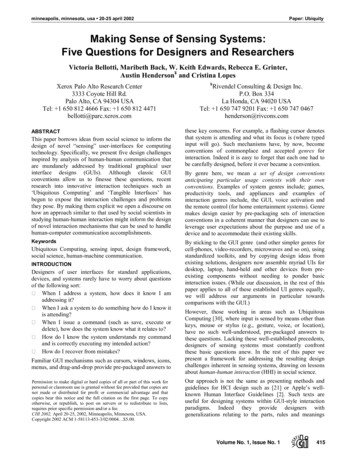
Transcription
How Designers and EngineersCan Achieve Gigabit Speedswith 4G LTETELIT WHITE PAPER 11.2020
IntroductionFor a while now, consumers have had access to gigabit speeds (UELTE Category 16 or above) in their smartphones. However, other4G LTE devices and applications are still limited to sub-Gigabit LTEspeeds and suboptimal service for customers and users. As a result,organizations from enterprises and manufacturing companies tomunicipalities, emergency first responders and others have beenmostly unable to realize the powerful benefits that 4G LTE gigabitspeed connectivity provides.Even as the world moves closer to fully commercial 5G, 4G GigabitLTE is an essential milestone for device makers, delivering extensivecoverage and value. Many of these network operators with GigabitLTE deployments plan to maintain those deployments even after 5G.ContentsIntroduction2In Search of Non-Consumer 4GGigabit LTE PerformanceHow to Achieve True Gigabit LTE4G LTE Use CasesPreparation Will Make Your Recipefor Gigabit Speed a SuccessThe Not-So-Secret Ingredient: TheTelit LM960A18 Module3According to the Gigabit LTE Networks May 2020 reportfrom the Global mobile Suppliers Association (GSA), 315operators in 142 countries or territories have deployed orlaunched networks that meet the LTE-Advanced mobilecommunication standard.It’s entirely possible to achieve gigabit speeds in 4G LTE devicesfor wide-ranging applications, but the right ingredients must beassembled in the right mix. Today, most 4G Gigabit LTE modules missa crucial component: the radio engineering completeness that givesfull Gigabit LTE performance in the uplink. Without a module capableof delivering 150 Mbps in uplink speed, 4G Gigabit LTE offers only amarginal improvement over standard LTE for most non-consumerapplication areas.Organizations looking for the rich and seamless user experience thatonly the most advanced 4G LTE standard provides need to follow aproven gigabit connectivity recipe. This recipe will guide them in theright direction to define gigabit project requirements before theyinvest. It will also lead them to ask the right questions and source theright ingredients for real gigabit success.2TELIT WHITE PAPERHow Designers and Engineers Can Achieve Gigabit Speeds with 4G LTE4788
In Search of Non-Consumer 4G Gigabit LTE PerformanceModules are the heart of non-consumer cellular-connected devices, whereas chips fulfill that role forcellular handsets and tablets. Many 4G LTE modules on the market promise full performance, and theirspec sheets seem to back them up. Still, almost all these modules fall short of delivering expectedspeeds in the field. What’s the problem? They don’t include all the ingredients required for successfulcarrier aggregation in real-world scenarios.What Is Carrier Aggregation, and How Can It Achieve Gigabit Performance?Gigabit 4G LTE operation requires that sections of cellular spectrum be combined to deliver enoughbandwidth carrying capacity to meet the UE Category 18 standard’s speed specifications. Thechallenge is that most mobile network operators (MNOs) in the United States own frequency rangesspread out in different mobile spectrum areas because of the Federal Communications Commission’s(FCC’s) spectrum allocation. Few carriers possess enough contiguous spectrum channels within thesame band (intraband) to support a combination that will deliver the full bandwidth.3TELIT WHITE PAPERHow Designers and Engineers Can Achieve Gigabit Speeds with 4G LTE
Therefore, original equipment manufacturers (OEMs) who want to take advantage of 4G LTE gigabitspeeds in their devices must use modules that can combine carriers from different spectrum bands.Known as carrier aggregation (CA), this capability must be applied in both downlink and uplinkdirections to achieve real gigabit performance, such as that specified in the UE Category 18 standard.Successful Gigabit LTE operation requires 4 x 4 multiple-input, multiple-output (MIMO) antennas, highorder modulation and interband CA capability.How to Achieve True Gigabit LTE1. Assemble the Right IngredientsEnsure you have the necessary components to attain the Gigabit LTE speed you need to support yourbusiness.The Gigabit LTE Networks May 2020 report found that 327 operators in 138 countries orterritories are investing in at least one of the vital component technologies necessary forGigabit LTE.4 x 4 MIMO AntennasEffective CA requires the use of 4 x 4 MIMO antennas instead of one or two antennas. Four-antennaarrays provide a much greater capability to interact with the base station and leverage spatial diversity.Higher speeds in gigabits cannot be accomplished with fewer antennas.Using MIMO antennas creates multiple radio paths, thereby improving the link’s “spectrum efficiency,”a measure of how efficiently the physical layer protocol uses a spectrum with limited frequency totransmit information.2 x 2 MIMO4 x 4 MIMO4 x 4 MIMO antennas provide 1.8x spectrum efficiency compared to the 1x spectrum efficiency providedby 2 x 2 MIMO antennas.4TELIT WHITE PAPERHow Designers and Engineers Can Achieve Gigabit Speeds with 4G LTE
Digital modulation maps data to positions in the amplitude/quadrature plane (symbols orconstellations).Interband CA on the UplinkWith intraband CA insufficient to meet spec, some module manufacturers have developed interbandCA for the uplink side. Interband CA combines noncontiguous sections (component carriers — CC) ofspectrum from separate frequency bands to achieve the broader bandwidth required for the wirelesssignals. Interband CA is one of the primary technologies needed to reach Gigabit LTE performance,supporting the high-speed uplinks and downlinks demanded by many use cases.New business models and bold new uses of cellular broadband rely heavily on the highest-performinguplink possible. Worldwide, networks have rolled out LTE Category 18 to support 150 Mbps peak uplinkspeed broadly. This performance level requires aggregation of two component carriers (contiguous orotherwise) relayed over 64-QAM and 4 x 4 MIMO. In some cases, with mobile operators that own thesetwo component carriers inside the same band, intraband CA can deliver the 150 Mbps uplink speed,but not consistently. However, with interband CA capability, carriers from two or more bands can becombined to produce the required radio bandwidth for 150 Mbps in the uplink. Combining carriers fromtwo or more bands is only possible if the module’s uplink radio has two parallel signal paths, capable ofsupporting an independently selected band.Uplink Radio Design in TypicalCommercial Grade Module5Uplink Radio Design inEnterprise Grade ModuleTELIT WHITE PAPERHow Designers and Engineers Can Achieve Gigabit Speeds with 4G LTE
2. Combine with Enterprise-Grade PerformanceAssembling the right ingredients is only the first step. Those ingredients must be combined in a 4G LTEmodule that supports the performance gigabit-speed use cases required to create a result that lives upto its promise. The module should offer:Enterprise-grade performance Robust and reliable performance and a rich feature set. Carrier approvals, regulatory compliance and global band support.Indoor and outdoor operation A full industrial operating temperature range.Ability to withstand a harsh environment Adherence to the highest standards of industrial manufacturing. Resilience to shock, vibration, dust and moisture.Support from a trusted partner6 Global technical support. A supply guarantee. Full component traceability, supplier qualification and automotive-grade processes.TELIT WHITE PAPERHow Designers and Engineers Can Achieve Gigabit Speeds with 4G LTE
4G LTE Use CasesAs true gigabit speeds have come within reach, the range of use cases for non-smartphone 4GLTE devices has grown ever broader and more diverse. Many of these use cases — such as firstresponder mobile devices — require fast uplink and downlink, making the need for interband CAa priority.Consumers: Smart home technologies, including smart appliances, fixed wireless broadband,security systems and cameras, all of which can be preprogrammed or accessed via smartphoneEnterprise SD-WAN (software-defined wide-area networking): Branch-office networking,collaboration, cloud computing, storage and backup, online file sync, multipoint video and webconferencing, telepresence, and virtual desktopsHealthcare: Hospital automation, patient device monitoring (such as pacemakers) andemergency patient-monitoring notification systemsIndustrial IoT: Smart distribution networks that direct the movement of components and finishedgoods across the supply chainPublic infrastructure: Smart city and transportation systems, such as sensor-enabled trafficmonitoring and signaling, and real-time public transportation informationEmergency and first responders: Mobile gear for police, firefighters, EMTs and other emergencyfirst responders, including vehicle-mounted and body-worn cameras and laptopsEducation and distance e-learning: Online classes and distance e-learning platforms, includingmassive open online courses (MOOCs), which enable many thousands of students worldwide toaccess classesAdvanced industrial imaging: X-ray and infrared images for testing product integrity andmeeting regulatory requirements7TELIT WHITE PAPERHow Designers and Engineers Can Achieve Gigabit Speeds with 4G LTE
Preparation Will Make Your Recipe for Gigabit Speed a SuccessThe benefits of 4G Gigabit LTE are here, ready for your next gigabit project. When you’re writing yournext request for quotation (RFQ), make sure you do the following before committing to a module: Perform field testing to confirm the datasheet specs (ask the company for an evaluation kit). Check the module’s certification status across multiple carriers. Check for module readiness and maturity. Make sure the module has dual-SIM capability so it can use multiple carriers. Perform testing in real-world conditions for the module’s performance with temperature, shock,vibration, dust, electromagnetic interference and other radio frequency issues, and its ability tocoexist with Wi-Fi, Bluetooth and other networks.One final important consideration to keep in mind: Chipset specifications don’t tell the whole story. Amodule is more than its chipset specs — its performance depends on other hardware. Don’t judge themodule by its chip. The surrounding technology is the critical part.The Not-So-Secret Ingredient: The Telit LM960A18 ModuleGigabit speed is only elusive if you don’t have the right ingredients, and only one 4G LTE modulecombines them all. The Telit LM960A18 is the only module available on the market today that canachieve interband uplink CA.Enterprise-Grade PerformanceThe Telit LM960A18 module has more CA combinations than all others in the certified-module category.Deploying multiple carriers requires interband CA in the uplink. Only the LM960A18 module supportsinterband in the uplink, making it the only module that can achieve the required maximum two-CAuplink speeds of 150 Mbps.The LM960A18 module is designed and built to the highest manufacturing standards to hold up underharsh real-life environments, including full industrial temperature range, shock, vibration, dust,moisture and more.Temperature Range ComparisonProduct8Temperature Range (Celsius)Telit LM960A18-40 to 85Leading Brand A-30 to 70Brand B-10 to 55Brand C-30 to 70TELIT WHITE PAPERHow Designers and Engineers Can Achieve Gigabit Speeds with 4G LTE
Gigabit-Speed Data CardsWith its Gigabit LTE performance and full certification for all major carriers worldwide, the TelitLM960A18 global Category 18 LTE data card is designed specifically for enterprise router and gatewayproducts. It’s the highest-category LTE PTCRB-certified data card supporting Gigabit LTE.Telit is also shipping the FN980m data card, which is based on Qualcomm Technologies’ secondgeneration 5G Snapdragon X55 5G New Radio (5G-NR) modem. The modem includes antenna modulesand integrated RF transceiver, RF frontend (RFFE) and antenna elements. These data cards are idealfor enterprise network appliances, branch and remote office routers, fixed wireless broadband internetaccess, and other bandwidth-intensive applications that can benefit from speeds in the 5 Gbps range.Find out more about 4G Gigabit LTE and how Telit can help you realize its benefits. Start exploringrobust, gigabit-speed Telit broadband solutions and request a consultation.[09.2020]Visit our interband blog and mobile broadband pillar page to find out more about interband andintraband CA.Telit reserves all rights to this document and the information contained herein. Products, names, logos and designs described herein may in whole or in part besubject to intellectual property rights. The information contained herein is provided “as is.” No warranty of any kind, either express or implied, is made in relation tothe accuracy, reliability, fitness for a particular purpose or content of this document. This document may be revised by Telit at any time. For most recent documents,please visit www.telit.comCopyright 2020, Telit
launched networks that meet the LTE-Advanced mobile communication standard. It's entirely possible to achieve gigabit speeds in 4G LTE devices for wide-ranging applications, but the right ingredients must be assembled in the right mix. Today, most 4G Gigabit LTE modules miss a crucial component: the radio engineering completeness that gives











